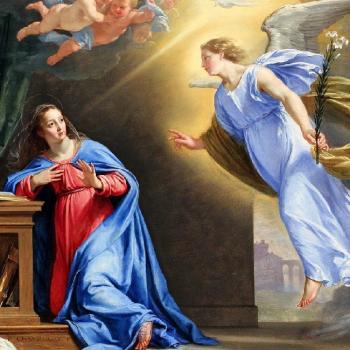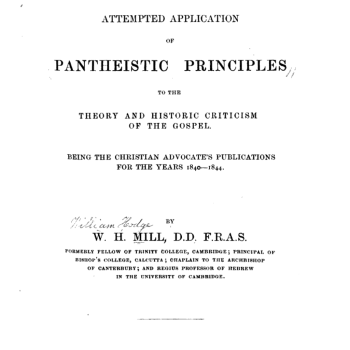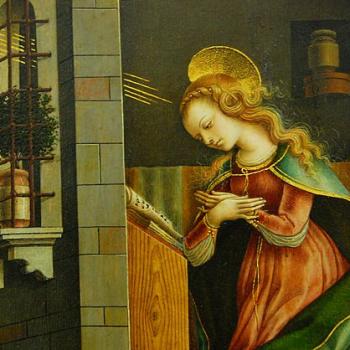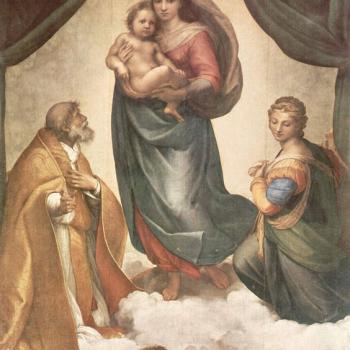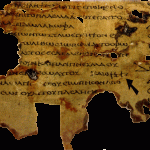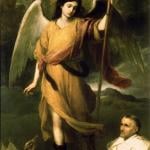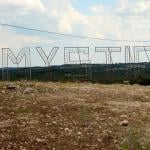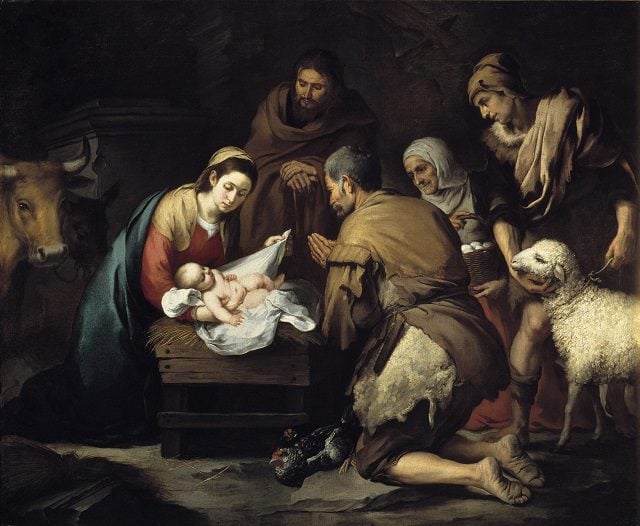
[for the necessary background, see my paper, Mary’s Perpetual Virginity “In Partu” (a Miraculous, Non-Natural Childbirth) is a Binding Catholic Dogma. The comments below were my related thoughts in a vigorous Facebook thread]
***
1. An intact hymen was how virginity was historically defined; not as simply the absence of intercourse.
2. An intact hymen means that birth was miraculous. The whole point is to preserve the utterly miraculous nature of the virgin birth: in conception and in the process of birth.
My job is to present all of Catholic dogma as it is: not to make more “difficult” ones palatable to the zeitgeist of the times.
Catholic Encyclopedia: “Virginity” explains the term as classically understood in the Church:
Morally, virginity signifies the reverence for bodily integrity which is suggested by a virtuous motive. Thus understood, it is common to both sexes, and may exist in a women even after bodily violation committed upon her against her will. Physically, it implies a bodily integrity, visible evidence of which exists only in women. The Catholic Faith teaches us that God miraculously preserved this bodily integrity, in the Blessed Virgin Mary, even during and after her childbirth (see Paul IV, “Cum quorundam”, 7 August, 1555).
This is what the Church means when she says that Mary was a virgin at conception, during the birth of Jesus, and after; as reflected in Catechism of the Catholic Church (CCC) #510:
Mary “remained a virgin in conceiving her Son, a virgin in giving birth to him, a virgin in carrying him, a virgin in nursing him at her breast, always a virgin” (St. Augustine, Serm. 186, 1: PL 38, 999): with her whole being she is “the handmaid of the Lord” (Lk 1:38).
In other words, Jesus was conceived without the sexual activity of a man or Mary. He was born in a miraculous way, and Mary never had sex after He was born (thus defeating all the nonsense about his having siblings, and preserving the absolutely miraculous mature of His conception and birth). This was universal patristic teaching.
Likewise, Fr. John A. Hardon, S.J., in his Modern Catholic Dictionary:
VIRGINITY OF MARY. The revealed dogma that the Mother of Jesus conceived without carnal intercourse, gave birth to Christ without injury to her virginity, and remained a virgin all her life. The Church’s faith in Mary’s virginal conception of Christ is expressed in all the creeds. Mary’s virginal conception was already foretold in the Old Testament by Isaiah in the famous Emmanuel prophecy: “Behold a virgin shall conceive and bear a son and his name shall be called Emmanuel” (Isaiah 7:14). Mary’s virginity includes virginity of mind, i.e., constant virginal disposition of soul; virginity of the senses, i.e., freedom from inordinate motions of sexual desire; and virginity of body, or physical integrity. The Church’s doctrine refers primarily to her bodily integrity.
The Blessed Virgin Mary’s intact hymen is settled dogma, which is determined by understanding how “virginity” was defined; as seen in the citation of Fr. Hardon above. See:
CCC 499 The deepening of faith in the virginal motherhood led the Church to confess Mary’s real and perpetual virginity even in the act of giving birth to the Son of God made man. In fact, Christ’s birth “did not diminish his mother’s virginal integrity but sanctified it.” And so the liturgy of the Church celebrates Mary as Aeiparthenos, the “Ever-virgin”.
Article 2. Whether Christ’s Mother was a virgin in His birth?
Objection 1. It would seem that Christ’s Mother was not a virgin in His Birth. For Ambrose says on Luke 2:23: “He who sanctified a strange womb, for the birth of a prophet, He it is who opened His Mother’s womb, that He might go forth unspotted.” But opening of the womb excludes virginity. Therefore Christ’s Mother was not a virgin in His Birth.
Objection 2. Further, nothing should have taken place in the mystery of Christ, which would make His body to seem unreal. Now it seems to pertain not to a true but to an unreal body, to be able to go through a closed passage; since two bodies cannot be in one place at the same time. It was therefore unfitting that Christ’s body should come forth from His Mother’s closed womb: and consequently that she should remain a virgin in giving birth to Him.
Objection 3. Further, as Gregory says in the Homily for the octave of Easter [xxvi in Evang., that by entering after His Resurrection where the disciples were gathered, the doors being shut, our Lord “showed that His body was the same in nature but differed in glory”: so that it seems that to go through a closed passage pertains to a glorified body. But Christ’s body was not glorified in its conception, but was passible, having “the likeness of sinful flesh,” as the Apostle says (Romans 8:3). Therefore He did not come forth through the closed womb of the Virgin.
On the contrary, In a sermon of the Council of Ephesus (P. III, Cap. ix) it is said: “After giving birth, nature knows not a virgin: but grace enhances her fruitfulness, and effects her motherhood, while in no way does it injure her virginity.” Therefore Christ’s Mother was a virgin also in giving birth to Him.
I answer that, Without any doubt whatever we must assert that the Mother of Christ was a virgin even in His Birth: for the prophet says not only: “Behold a virgin shall conceive,” but adds: “and shall bear a son.” This indeed was befitting for three reasons. First, because this was in keeping with a property of Him whose Birth is in question, for He is the Word of God. For the word is not only conceived in the mind without corruption, but also proceeds from the mind without corruption. Wherefore in order to show that body to be the body of the very Word of God, it was fitting that it should be born of a virgin incorrupt. Whence in the sermon of the Council of Ephesus (quoted above) we read: “Whosoever brings forth mere flesh, ceases to be a virgin. But since she gave birth to the Word made flesh, God safeguarded her virginity so as to manifest His Word, by which Word He thus manifested Himself: for neither does our word, when brought forth, corrupt the mind; nor does God, the substantial Word, deigning to be born, destroy virginity.”
Secondly, this is fitting as regards the effect of Christ’s Incarnation: since He came for this purpose, that He might take away our corruption. Wherefore it is unfitting that in His Birth He should corrupt His Mother’s virginity. Thus Augustine says in a sermon on the Nativity of Our Lord: “It was not right that He who came to heal corruption, should by His advent violate integrity.”
Thirdly, it was fitting that He Who commanded us to honor our father and mother should not in His Birth lessen the honor due to His Mother.
Reply to Objection 1. Ambrose says this in expounding the evangelist’s quotation from the Law: “Every male opening the womb shall be called holy to the Lord.” This, says Bede, “is said in regard to the wonted manner of birth; not that we are to believe that our Lord in coming forth violated the abode of her sacred womb, which His entrance therein had hallowed.” Wherefore the opening here spoken of does not imply the unlocking of the enclosure of virginal purity; but the mere coming forth of the infant from the maternal womb.
Reply to Objection 2. Christ wished so to show the reality of His body, as to manifest His Godhead at the same time. For this reason He mingled wondrous with lowly things. Wherefore, to show that His body was real, He was born of a woman. But in order to manifest His Godhead, He was born of a virgin, for “such a Birth befits a God,” as Ambrose says in the Christmas hymn.
Reply to Objection 3. Some have held that Christ, in His Birth, assumed the gift of “subtlety,” when He came forth from the closed womb of a virgin; and that He assumed the gift of “agility” when with dry feet He walked on the sea. But this is not consistent with what has been decided above (Article 14). For these gifts of a glorified body result from an overflow of the soul’s glory on to the body, as we shall explain further on, in treating of glorified bodies (XP, 82): and it has been said above (13, 3, ad 1; 16, 1, ad 2) that before His Passion Christ “allowed His flesh to do and to suffer what was proper to it” (Damascene, De Fide Orth. iii): nor was there such an overflow of glory from His soul on to His body.
We must therefore say that all these things took place miraculously by Divine power. Whence Augustine says (Sup. Joan. Tract. 121): “To the substance of a body in which was the Godhead closed doors were no obstacle. For truly He had power to enter in by doors not open, in Whose Birth His Mother’s virginity remained inviolate.” And Dionysius says in an epistle (Ad Caium iv) that “Christ excelled man in doing that which is proper to man: this is shown in His supernatural conception, of a virgin, and in the unstable waters bearing the weight of earthly feet.”
In a General Audience of Jan 28, 1987, Pope St. John Paul II cited the above text from the Lateran Council:
Mary was therefore a virgin before the birth of Jesus and she remained a virgin in giving birth and after the birth. This is the truth presented by the New Testament texts, and which was expressed both by the Fifth Ecumenical Council at Constantinople in 553, which speaks of Mary as ‘ever virgin’, and also by the Lateran Council in 649, which teaches that ‘the mother of God…Mary…conceived [her Son] through the power of the Holy Spirit without human intervention, and in giving birth to him, her virginity remained incorrupted, and even after the birth her virginity remained intact.
On June 10, 1992, during a talk in Capua, Italy, he further stated:
It is a well-known fact that some of the Church Fathers set us a significant parallel between the begetting of Christ ex intacta virgine [from the inviolate Virgin] and his resurrection ex intacto sepulcro [from the sealed tomb]. In the parallelism relative to the begetting of Christ, some of the Fathers put the emphasis on the virginal conception, others on the virgin birth, others on the subsequent perpetual virginity of the Mother, but they all testify to the conviction that between the two saving events – the generation–birth of Christ and his resurrection from the dead – there exists an intrinsic connection which corresponds to a precise plan of God: a connection which the Church led by the Spirit, has discovered, not created.
. . . . [I]t is necessary for the theologian, in presenting the Church’s doctrine on Mary’s virginity to maintain the indispensable balance between stating the fact and elucidating its meaning. Both are integral parts of the mystery: the meaning, or symbolic value of the event is based on the reality of the fact, and the latter, in turn, reveals all its richness only if its symbolic meanings are unfolded.
See much more excellent materials along these lines. Fr. William Most also defends Mary’s virginity in partu against liberal dissident notions. Eastern patristic evidence is abundant, as well:
Mary’s virginity was hidden from the prince of this world; so was her childbearing, and so was the death of the Lord. All these three trumpet-tongued secrets were brought to pass in the deep silence of God. (St. Ignatius of Antioch, Epistle to the Ephesians, 19; c. 107 AD)
Who loves you is amazed and who would understand is silent and confused, because he cannot probe the Mother who gave birth in her virginity. If it is too great to be clarified with words the disputants ought not on that account cross swords with your Son. (St. Ephraim the Syrian, Songs of Praise, 1, 2)
Believe in the Son of God, the Word before all the ages, who was…in these last days, for your sake, made Son of Man, born of the Virgin Mary in an indescribable and stainless way,-for there is no stain where God is and whence salvation comes… (St. Gregory of Nazianzen, Oration on Holy Baptism, 40:45; 381 AD)
Though coming in the form of man, yet not in every thing is He subject to the laws of man’s nature; for while His being born of a woman tells of human nature; virginity becoming capable of childbirth betokens something above man. Of Him then His mother’s burden was light, the birth immaculate, the delivery without pain, the nativity without defilement, neither beginning from wanton desire, nor brought to pass with sorrow. For as she who by her guilt engrafted death into our nature, was condemned to bring forth in trouble, it was meet that she who brought life into the world should accomplish her delivery with joy. (St Gregory of Nyssa, Homily on the Nativity 388 AD?)
O mystery! I see miracles, and I proclaim the Godhead: I perceive sufferings, and I do not deny the humanity. For Emmanuel opened the doors of nature as man, but as God did not break through the bars of virginity. (St. Proclus of Constantinople, Oratio 1, no. 10; PG 65:692A).
How can death claim as its prey this truly blessed one, who listened to God’s word in humility, and was filled with the Spirit, conceiving the Father’s gift through the archangel, bearing without concupiscence or the co-operation of man the Person of the Divine Word, who fills all things, bringing Him forth without the pains of childbirth, being wholly united to God?… It was fitting that the body of her, who preserved her virginity intact in childbirth, should be kept from corruption even after death. She who nursed her Creator as an infant at her breast, had a right to be in the divine tabernacles…. It was fitting that she who saw her Son die on the cross, and received in her heart the sword of pain which she had not felt in childbirth, should gaze upon Him seated next to the Father. (St. John Damascene, Second Homily on the Dormition of the Mother of God)
So far as He was born of woman, His birth was in accordance with the laws of parturition, while so far as He had no father, His birth was above the nature of generation: and in that it was at the usual time (for He was born on the completion of the ninth month when the tenth was just beginning), His birth was in accordance with the laws of parturition, while in that it was painless it was above the laws of generation. For, as pleasure did not precede it, pain did not follow it, according to the prophet who says, Before she travailed, she brought forth, and again, before her pain came she was delivered of a man-child (Isaiah 66:7). The Son of God incarnate, therefore, was born of her, not a divinely-inspired man but God incarnate…. But just as He who was conceived kept her who conceived still virgin, in like manner also He who was born preserved her virginity intact, only passing through her and keeping her closed (Ezekiel 44:2). (St. John Damascene, On the Orthodox Faith, IV, 14)
The author of one article on the topic (not credited), wrote: “The only early Church writers who rejected this belief were Tertullian, Jovinian and Helvidius, all of whom were heretics.”
One doesn’t have to specifically mention intact hymens if it is already understood (as I would contend) that this is the literal meaning of “virginity”. Rather, these utterances have to be understood in context. If the Blessed Virgin’s virginity or “integrity” etc. is intact during childbirth, then we have to ask what this means. What does it mean to be “a virgin during childbirth”? It obviously has nothing to do with having intercourse or not. Those statements are referring to physical virginity; understood throughout Church history as an intact hymen.
No one has yet explained to me what in the world it means to say “a virgin during childbirth” if it is not the notion of in partu virginity, as explained. If it’s not that, it must mean something else. So what else is there that it could mean?
If we were merely talking about the absence of sexual activity, it would make no sense to note that Mary was a virgin “during” childbirth. That would be understood as following from the virgin birth (or I should say, virginal conception), without having to mention it.
It was noted precisely because it is another aspect of the miracle of the incarnation: a miraculous birth as well as miraculous conception.
I have a few more quotes from my book, Quotable Eastern Church Fathers. Some may overlap what I gave above:
Seek not the sequence of nature, he says, when that which takes place is above nature; look not round for marriage and throes of child-birth, when the manner of the birth is too grand for marriage. (St. John Chrysostom, Homily Against Publishing the Errors of the Brethren, and Uttering Imprecations upon Enemies, 7; NPNF1-9)
But in Thy Resurrection Thou persuadest them concerning Thy Birth; since the womb was sealed, and the sepulchre closed up; being alike pure in the womb, and living in the sepulchre. The womb and the sepulchre being sealed were witnesses unto Thee. . . . she conceived Thee not by nature after Thou wast come, O Holy One, and was a Virgin when she had brought Thee forth holily. (St. Ephraim, Hymns on the Nativity: VIII; NPNF2-13)
. . . this blessed woman, who was deemed worthy of gifts that are supernatural, suffered those pains, which she escaped at the birth, in the hour of the passion, . . . (St. John Damascene, An Exact Exposition of the Orthodox Faith, IV, 14; NPNF2-9)
Being God He becomes man, and is marvellously brought forth without detriment to the virginity of His Mother. . . . Is it not thee, conceiving without man and still remaining a virgin? Let the inspired Ezechiel come forth and show us the closed gate, sealed by the Lord, and not yielding, according to his prophecy–let him point to its fulfilment in thee. The Lord of all came to thee, and taking flesh did not open the door of thy virginity. The seal remains intact. (St. John Damascene, Sermon I on the Assumption)
But she is ever a virgin, before the event, in the birth itself, and afterwards. . . . She brought Him forth without pain, . . . who preserved her virginity unsullied in her motherhood, . . . (St. John Damascene, Sermon II on the Assumption)
We shouldn’t excommunicate people who don’t grasp what in partu means, or that it is a Catholic dogma; we should educate them. Unfortunately, there is some erroneous teaching on this score floating around, even from Catholic Answers (thus, there is more excuse for folks to be confused or wrong). Other apologists, like Mark Shea, realized they were mistaken and publicly changed their view.
I’ve had my own growth in this area. I would have argued otherwise, 20 years ago or even more recently. But I learned more stuff and changed my mind as to Church teachings on it. I yield to the wisdom and teachings of Holy Mother Church.
Anything that has anything whatever to do with sex, must be questioned these days. So early on in the discussion [not included above] we heard the common “Church is anti-sex” / docetism / gnosticism themes crop up. Lots of folks think the Church holds to the entire doctrine of perpetual virginity (and consecrated celibacy), let alone in partu virginity, primarily for these reasons: missing the entire point: that it is always Christocentric in purpose and essence: just as in all other Marian doctrines.
People will believe what they believe. My job is to try to explain, as best I can, the Church’s teaching and why it is held. Mostly I’ve cited others who know far more than I do about it. But I think I may have offered a few helpful tidbits to the discussion here and there.
An afternoon listening to Debussy orchestral transcriptions and discussing in partu . . . what a life I lead! Yesterday and the day before I wrote about how the Via Dolorosa is likely in the wrong place. I’m sure that could make me very unpopular in some circles as well. Being an apologist is like being an umpire. We’re always displeasing someone . . .
* * *
(originally 9-19-14; slight modifications and additions on 4-18-18)
Photo credit: The Adoration of the Shepherds (c. 1650), by Bartolomé Esteban Murillo (1617-1682) [public domain / Wikimedia Commons]
***




